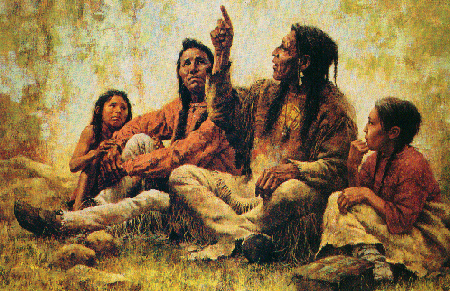Dhr. Seven (ed.), Wisdom Quarterly; Hendon Harris (chinesediscoveramerica.com)
 |
| Tibetan store (Aaron Berkovich/flickr) |
Buddhism began in the sixth century BCE in India [although the Buddha was from neighboring Afghanistan -- the ancient northwestern frontier of Gandhara and to points west -- where the Dharma quickly took hold among his familial clan simultaneous with its spread in Magadha/modern Bihar, India].
It soon spread to ancient Greece and parts of its empire in Central Asia [Bactria, Sogdiana, etc., where Alexander the Great left yet another "Alexandria" in Kandahar, Afghanistan, when it was part of the Hellenic Empire], the geopolitical Middle East, and some believe to Europe (Kalmykia) as far north as Scandinavia and even North America, which was partly ancient Mexico, a spread Rick Fields documented in How the Swans Came to the Lake: A Narrative History of Buddhism in America and Edward P. Vining's Inglorious Columbus, which recounts how a group of Afghan Buddhist monks led by Chinese Buddhist missionary Hwui Shan "discovered" America and therefore interacted with the Native Americans long before the genocidal, Polish, Jewish Christopher Columbus].
This is where the Native Anasazi (or Ancestral Puebloan people, such as the Hopi, Hisatsinom, and others) come in.
One piece of evidence is the ancient Buddhist proclivity for carving building and shrines into mountains and creating distinctive rock formations. They are now found all over the world and bear a likeness to that favored by Vedic Hinduism/Buddhism. Buddhism ultimately reached China in the first century ACE, after it had made a grand impact on Greece bringing in many Eastern philosophical idea -- the atom (kalapa), democratic voting and rudimentary parliamentary rules of order (Sangha organization according to the Vinaya), and so on.
The Anasazi culture mysteriously appeared in North America at an undetermined time and disappeared about 1300 ACE. Where did these incredibly advanced people come from? How and why did they just as mysteriously disappear? We know they were astronomers because we have found some of their observatories. We know they were road builders because we have found their roads. We know they were incredibly proficient at stone carving and masonry because we have found evidence of their work and architectural styles in the Four Corners area of the Southwest.
 |
| Native American indigenous Apache, remnant Anasazi spirit dancers, 1887 (Native Skeptic) |
These architectural styles and art carved in stone provide the best evidence that the source of the Anasazi culture with its advanced knowledge and artistry was Vedic Asia.
This is a provocative statement likely to offend a few scholars. However, if one takes the time to examine the art and architecture, compare examples from each culture side by side, it will provide clear evidence of their connection.
 |
| Rock cliffs of the Grand Canyon, Arizona |
Further search “Architecture-Pueblo complexes and Great Houses” or “Bandelier National Park Rock Cave Images” to see more). Compare these to the Caves of Dunhuang and the Longmen Caves in China or to the recently discovered Shangri-la Buddhist Caves of Nepal all of which are carved high up on rock faces.
 |
| Luoyang Shaolin Buddhist temple (G-W-H) |
 |
| Tibetan structures are like Puebloan dwellings of the Southwest. This American adobe complex was likely built between 1000-1450 AD near Taos, New Mexico, USA (wiki). |
 |
| Rock-cut remains, Bandelier, NM, USA |
The Bisti Badlands are an interesting place in the Four Corners region, where the Anasazi people lived. However, the common opinion is that “The Canadian Goose Bisti,” “The Sleeping Lizard Bisti,” “The Flying Turtle Bisti,” and so on are simply random acts of erosion. A more plausible explanation is that these rock formations are ruins of a people exhibiting a Vedic cultural heritage because of at least three different types of rock formations there.
- Mushroom rocks like the ones found at Mushroom State Park, Kansas are found throughout these 45,000 acres of badlands. “Mushroom Rocks” are the chattra symbols of ancient Buddhism. Chattra is the Sanskrit word for “mushroom,” which is also the word for the Parasol, one of the Eight Auspicious Symbols of Buddhism. More


This is truly a well laid out article. However, most of the material you use here has been lifted practically word for word from articles I have previously written on this topic. Furthermore, you don't give me any credit anywhere on this site even after taking my material verbatim without my permission. This is not only not cool, it's illegal.
ReplyDeleteGoogle: "Church Rock Cathedral in the Desert"
ReplyDeleteGoogle: "A Kapruka Pujawa at Ruwanweliseya Muhasaya" & "Observe the Colorful Buddhist Flag Wrapping Ceremony at Ruwanweliseya Stupa"
ReplyDelete"Wrapped Stupa Images" and "Wrapped Stupa Utah"
ReplyDeleteFor detailed video images of Church Rock and the surrounding area google:
ReplyDelete"Church Rock Utah Drone Videos"
For short postings on evidence of ancient and Pre Columbian Asian influences in North America: "Fu Sang- The Last Wilderness by Ken Campbell"
ReplyDelete"Did the Chinese Discover America": Dr. Michael Heiser
ReplyDelete"Ancient Buddha, Tree of Life, Lotus Flower Geoglyph Colorado"
ReplyDelete"Fu Sang- The Last Wilderness"
ReplyDelete"The Fundamental Cartographical Technology of Ancient China -
ReplyDeleteForward Intersection" Dr. Zilan Wang Cambridge